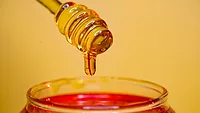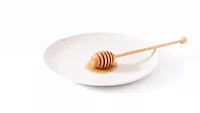Scientists Develop Cost-Effective Sensor to Detect Water Adulteration in Honey

Image credit: Arwin Neil Baichoo via Unsplash
Scientists from the Nanjing University of Aeronautics and Astronautics (NUAA) and the Hebei University of Technology (HUT) have developed a sensor that can detect water adulteration of honey, a commodity that is often the subject of fraudulent food production practices.
Recent reports from the European Food Safety Authority (EFSA) and the U.S. Food and Drug Administration (FDA) highlight the widespread issue of fraudulent honey on the market, finding that nearly half of honey imported to the EU and 10 percent of honey on the U.S. market is adulterated. Water is a common ingredient used for economically motivated honey adulteration.
When water is added to honey, it changes how the electromagnetic field behaves around it. The microstrip line resonator sensor developed by the NUAA and HUT researchers leverages the differences in electromagnetic activity, signaling the presence of water in honey through a shift in the sensor’s resonance frequency. By measuring the shift, the user of the sensor is able to detect water adulteration.
The research team tested honey samples with varying water content using the sensor, and found the sensor’s resonance frequency to consistently decrease with increased water content.
The sensor is fabricated on a dielectric substrate, which is an insulator that can efficiently support electrostatic fields, such as ceramic or glass. On top of the sensor there are three thin copper strips separated by two gaps. The length of the middle strip and the electric field intensity at the gaps determine the resonance frequency of the device.
The solution is easy to produce, small, and cost-effective, as opposed to standard detection methods for honey adulteration, which can be expensive, complicated to operate, or have low detection accuracy. The scientists believe that the technology powering the sensor can be adapted to other applications, and intend to continue their research to detect adulteration in other liquid products and develop more sensitive sensors for broader applications in quality control and food safety.
Looking for quick answers on food safety topics?
Try Ask FSM, our new smart AI search tool.
Ask FSM →









